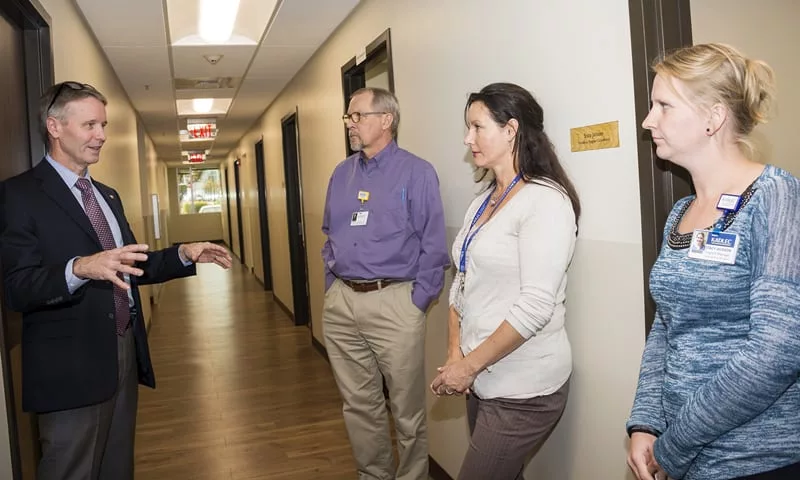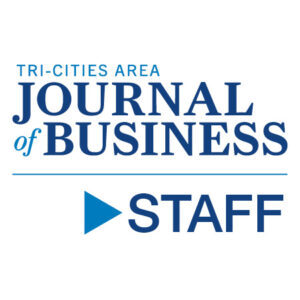
Home » Kadlec to offer clinical rotations for WSU College of Medicine students
Kadlec to offer clinical rotations for WSU College of Medicine students

January 10, 2016
As Washington State University moves toward the creation of the Elson S. Floyd College of Medicine, Kadlec Regional Medical Center is positioning itself to become an integral part of the program by offering clinical rotations for the residency program.
[blockquote quote="We hope this (partnership) will result in physicians who are familiar with the community and interested in staying and practicing in the area." source="Lane Savitch, president & CEO of Kadlec Regional Medical Center" align="right" max_width="300px"]
The WSU board of regents established the WSU School of Medicine earlier this year, after the Washington State Legislature amended a 1917 statute that gave the University of Washington exclusive rights to grant medical degrees in the state. The name was changed to the Elson S. Floyd College of Medicine in September.
In early December, college administrators submitted its initial application documents to the Liaison Committee on Medical Education, or LCME, the national accrediting agency for allopathic medical schools in the U.S. and Canada.
WSU has hired John Tomkowiak, formerly of the Chicago Medical School, as the College of Medicine’s founding dean and Ken Roberts as the vice dean.
The team is planning to create a medical school that has branches throughout the state, including in the Tri-Cities.
Kadlec Regional Medical Center has entered into an agreement with the College of Medicine to teach third- and fourth-year students. Although the first WSU College of Medicine students won’t start their clinical rotations until at least 2019, the College is already working with Kadlec officials to create the clinical residency program.
“This regional will be facing a shortage of physicians in the future,” said Lane Savitch, Kadlec president and CEO. “In fact we are struggling right now to recruit the physicians we need in almost every specialty. We hope this (partnership) will result in physicians who are familiar with the community and interested in staying and practicing in the area.”
Initially, the WSU College of Medicine is going to have community-based residency programs in the Tri-Cities, Spokane, Vancouver and Everett, with the hopes of offering residencies in more rural communities in the future.
“Since October we have been going around the state and talking with the community-affiliate partners, who have been really enthusiastic,” said Founding Dean John Tomkowiak. “Kadlec has been one of the leaders in terms of advocating for the school and they have been a wonderful partner.”
Kadlec’s previous work with WSU made it easy for the College to approach the hospital about the clinical residency program, Roberts added.
In 2012, Kadlec contributed $250,000 and a 12,000-sq.-ft. facility on Lee Boulevard to create a training center for the WSU Tri-Cities nursing education program.
And earlier this year, the hospital donated $18 million to endow five new faculty positions, which will be part of the Doctor of Nursing Practice program in the Tri-Cities.
“This is a big thing because we need these partnerships to provide places where students can work aside working practitioners,” Roberts said.
The first- and second-year students will do their academic, or classroom work, at the WSU Spokane campus. Then in their third and fourth years, the students will do their clinical residencies in the Tri-Cities, Vancouver, Everett or Spokane.
Roberts said the new medical school will strive to find qualified students from those areas during the admissions process.
“We want to use our admissions programs to look for qualified people coming from those areas because part of what drives where a physician winds up practicing is where they grew up and where they trained,” he said.
The school will also be very focused on promoting primary care.
“You have to give students a well-rounded education, but we want to also give them a good feeling about how primary care is practiced,” he said.
Roberts said that the inaugural class will likely consist of about 60 students and finding the right students to fill that class is very important.
“That’s a group of students who are going through the process with us,” he said. “They will be pioneers in a lot of ways. That group of students is extremely important for providing feedback and telling us what types of things need to be adjusted.”
But before those students can crack the books, there’s still a lot of work to be done, Tomkowiak said.
Tomkowiak said they have studied how other medical schools with similar models created their program and that the WSU school is very similar to one at Florida State University.
“One of the lessons we have learned is that for the campus to be successful, there really has to be buy-in from the ground level up that speaks toward the importance of the school,” he said. “So we want to spend a lot of time working with physicians and other health professionals — letting them know what the school is about and how we will train the students.”
Because students will be doing their residencies at four different hubs, the management team has to make sure that all are being exposed to common elements and regardless of where they are being trained, they receive the same quality education.
That can only happen with proper training and communication, Tomkowiak said.
“We will be in the Tri-Cities, developing the teams of clinicians and health providers who will train the students and we will help them understand how to work with the students and how to evaluate them,” he said.
Cultural and strategic planning sessions have already started, he added.
Savitch said the program will offer the Tri-Cities the same type of pipeline to home-grown providers as the WSU Tri-Cities nursing program does.
In addition, the students who go through the clinical residency program in the Tri-Cities will experience something they won’t get at a one of the well-established medical schools, which are only found in large metropolitan areas.
“This is a good teaching area because it’s not in an urban center, which is often what physicians get use to during their training,” Savitch said. “They will have a more community-based education that will create more familiarity with a community-based facility.”
Tomkowiak said that although the clinical residency portion of the program will start with just four hubs, he hopes to see that expand in the future.
“WSU is a land-grant school and it’s our expectation that we will touch every county in the state,” he said. “Even though our model will be centered at these four campuses, we hope to be in the entire state down the road. And we have a vision of how to get there.”
Health Care





